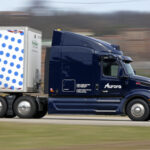Driverless trucks with no humans on board will soon cruise Texas highways if three startup firms have their way, despite objections from critics who say financial pressures, not safety, is behind the timetable.
After years of testing, Aurora Innovation Inc., Kodiak Robotics Inc. and Gatik AI Inc. expect to remove safety drivers from trucks that are being guided by software and an array of sensors including cameras, radar and lidar, which sends pulses of light that bounces off objects. The companies have already hauled cargo for big names such as Walmart Inc., Kroger Co., FedEx Corp. and Tyson Foods Inc.
“At the end of the year, we anticipate getting to the point where we begin operating those trucks without drivers on board,” Chris Urmson, co-founder and chief executive officer of Pittsburgh-based Aurora, said in an interview.
All of the companies say they’re ready to deploy the technology, though they know there’s little-to-no margin for error. The risk is worth it, they say, because the technology promises to improve highway safety and lower transportation costs.
Detractors say the companies have incentive to reduce the losses that investors have been financing during the development and testing phase.
“We are concerned about the lack of regulation, the lack of transparency, the lack of comprehensive data collection,” said Cathy Chase, president of Advocates for Highway and Auto Safety. The list of opponents also includes the International Brotherhood of Teamsters, the 1.3 million member union that represents drivers and warehouse workers.
And trucks pose severe dangers, opponents say, because they will be traveling at highway speeds and weigh as much as 80,000 pounds, or more than 15 times as much as General Motors Co.’s troubled Cruise driverless robotaxi.
The federal government for now has left regulation of driverless large trucks mostly up to states, creating a patchwork of rules. California suspended Cruise operations in October after several incidents in San Francisco. California’s lack of rules for allowing trucks to be tested on public roads encouraged the three driverless truck firms and others to turn to Texas for testing and deployment.
The difficulties that Cruise’s robotaxis faced on the streets of San Francisco — unpredictable pedestrians, sudden road closures and emergency vehicles — are less of a problem for driverless trucks, according to the companies. Trucks largely move cargo on fixed routes and mostly on highways that require much less interaction with passenger vehicles and pedestrians.
Besides saving on trucker pay, the trucks can travel longer than the 11-hour limit now on human drivers. The sensors scan in all directions several times a second to identify objects, speeding up reaction time. There are even estimated savings on emissions of 10 percent or more because the vehicles will stay just below the speed limit and travel at a steady cadence, the companies say.
And human drivers don’t guarantee safe operations. In 2021, 5,700 large trucks, which weigh 10,001 pounds or more, were involved in fatal crashes, according to statistics compiled by the Federal Motor Carrier Safety Administration. A majority of those incidents came from trucks with a gross weight of 33,001 pounds or more. These so-called Class 8 trucks are similar in size to those in Kodiak and Aurora fleets.
While driverless trucks haven’t had any at-fault incidents with other vehicles in testing with safety drivers, the FMCSA report suggests that they may not be immune to accidents. Nearly two-thirds of fatal accidents occur when a person, object, animal or other vehicle veers into a truck’s lane. Data collected by a self-driving truck’s computer system will be key to determining what caused an accident.
“They can’t just say we’re better than humans,” said Brian Ossenbeck, a transportation industry analyst with JPMorgan Chase, of the companies planning to go driverless this year. “They have to reach that superhuman level, at least initially, until there’s broader acceptance. And who knows how long that would take.”
Meeting the Goal
At Aurora’s terminal just south of Dallas, a worker cleans sensors on top and at the side of a dark blue Peterbilt truck while a safety driver sits in the cab ready for the truck to pull out. If all goes as planned, the safety driver, whose hands now hover above the wheel without touching it while the truck is in transit, will soon no longer be needed for the 200-mile trek to Houston.
“Our intent is this is going to feel like just another day, except this day the truck’s going to head out on the road without anybody in it,” said Urmson.
Wall Street will be watching closely to see if Aurora meets its goal of going driverless by the end of 2024, said Jeff Osborne, an analyst with TD Cowen, who has a “market perform” rating on the stock. Otherwise, investors will raise cash-burn concerns, he said.
“If something is slightly delayed, you just end up getting punished,” Osborne said.
The startup raised $850 million this summer, giving it enough cash to operate through the second half of 2025. Aurora then aims to raise a similar amount to carry it through 2027, when it’s expected to turn a profit, Urmson said.
Gatik AI, a Mountain View, California-based startup, has already driven trucks without a driver in Arkansas and Canada. The company uses smaller, box trucks and plans to deliver from distribution centers to stores. In 2024, the company expects to deploy driverless trucks in the Dallas area “at scale,” said Gautam Narang, Gatik’s co-founder and CEO, in an interview.
Kodiak plans to “start small in 2024 and gradually ramp it up as we build confidence in the system that we didn’t miss anything,” said Don Burnette, CEO of the closely held Mountain View, Calif.-based company that he founded in 2018. “We’ve seen the damage that can be done,” as in the case of robotaxis in San Francisco, he said.
The first operations without a human aboard will be short runs near the company’s truck terminal just south of Dallas and extend from there, said Burnette.
The companies have truckport partners to help with refueling their diesel-powered fleets and roadside assistance in case of a flat tire.
Open Road
For now, it’s mostly southern states – from Arizona to Florida – that allow self-driving trucks. Kodiak has been hauling cargo with a safety driver from Dallas to Atlanta and from Houston to Oklahoma City. Most companies plan to start in the south because there’s less inclement winter weather.
Texas first adopted legislation allowing driverless trucks in 2017. State authorities have worked with the startups to address issues such as inspections and how law enforcement will interact with a driverless truck.
“Autonomous vehicles are expected to help improve safety, spur economic growth and improve the transportation experience for all Texans,” the Texas Department of Transportation said in a statement.
Still, the self-driving startups realize that state and federal regulators “have the ability to force a recall and stop the operation of vehicles if they believe they’re creating unreasonable risk to the motoring public,” Urmson said. The potential transformation of the trucking industry will depend on whether the initial driverless runs are completed without a hitch.





















 Is the AI Boom a Bubble Waiting to Pop? Here’s What History Says
Is the AI Boom a Bubble Waiting to Pop? Here’s What History Says  Executives on the Move at Liberty Mutual, Cowbell, W. R. Berkley
Executives on the Move at Liberty Mutual, Cowbell, W. R. Berkley  Breaking: Andersen to Replace Zaffino as CEO of AIG on June 1
Breaking: Andersen to Replace Zaffino as CEO of AIG on June 1  Nearly Half of 100 Largest P/C Insurers Destroy Value: ACORD
Nearly Half of 100 Largest P/C Insurers Destroy Value: ACORD 
